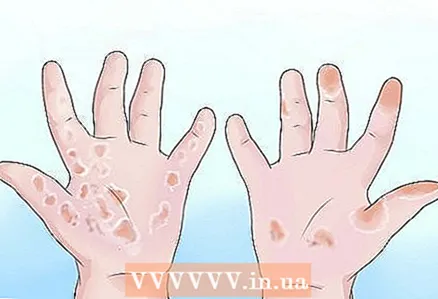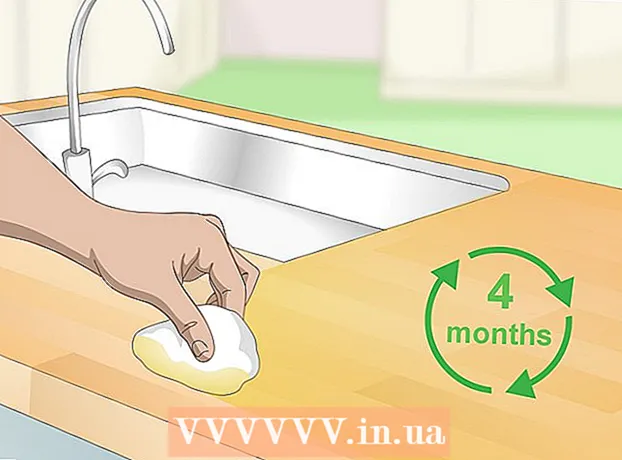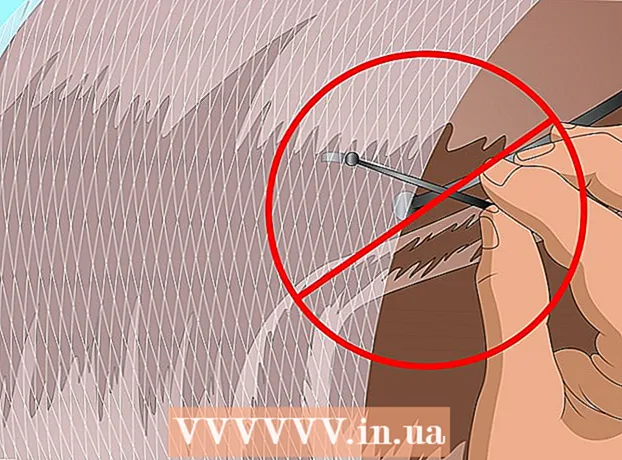Author:
Ellen Moore
Date Of Creation:
16 January 2021
Update Date:
1 July 2024

Content
- Steps
- Method 1 of 3: Symptoms of streptococcal pharyngitis
- Method 2 of 3: Know How Scarlet Fever Develops
- Method 3 of 3: Risk Factors
Scarlet fever is an infectious disease caused by toxins produced by group A streptococcus. Often the disease is transmitted from a patient with streptococcal pharyngitis. About 10% of streptococcal infections turn into scarlet fever. If you start showing symptoms of scarlet fever, see your doctor right away for antibiotics.
Steps
Method 1 of 3: Symptoms of streptococcal pharyngitis
 1 Beware of sore throat. Sore throat does not always indicate strep, but it is still the most common symptom. Watch out for sore throat and difficulty swallowing. The effect of strep is often seen on the tonsils at the back of a child's throat. They can turn red and swell. White spots and traces of pus may also appear on the tonsils.
1 Beware of sore throat. Sore throat does not always indicate strep, but it is still the most common symptom. Watch out for sore throat and difficulty swallowing. The effect of strep is often seen on the tonsils at the back of a child's throat. They can turn red and swell. White spots and traces of pus may also appear on the tonsils.  2 Beware of common symptoms of the disease. Streptococcal pharyngitis can also be accompanied by fatigue, abdominal pain, vomiting, headache, and fever. Sometimes the lymph nodes are enlarged (a large protruding formation on the neck, often in front).
2 Beware of common symptoms of the disease. Streptococcal pharyngitis can also be accompanied by fatigue, abdominal pain, vomiting, headache, and fever. Sometimes the lymph nodes are enlarged (a large protruding formation on the neck, often in front). - Usually, lymph nodes cannot be felt. If they have increased to such an extent that they can be felt, then you most likely have an infection. They can also be sore when touched and have a reddish tint.
 3 See your doctor if your sore throat persists for more than 48 hours. Be equally careful if a child's sore throat is accompanied by swelling of the lymph nodes or an increase in temperature above 38.3 ° C.
3 See your doctor if your sore throat persists for more than 48 hours. Be equally careful if a child's sore throat is accompanied by swelling of the lymph nodes or an increase in temperature above 38.3 ° C.
Method 2 of 3: Know How Scarlet Fever Develops
 1 Beware of rising temperatures. If streptococcal pharyngitis turns into scarlet fever, then the child's body temperature begins to rise. As a rule, scarlet fever is accompanied by a temperature of 38.3 ° C and above. Sometimes a chill may accompany a fever.
1 Beware of rising temperatures. If streptococcal pharyngitis turns into scarlet fever, then the child's body temperature begins to rise. As a rule, scarlet fever is accompanied by a temperature of 38.3 ° C and above. Sometimes a chill may accompany a fever. - 2 Beware of impetigo. Instead of a sore throat, scarlet fever can sometimes be accompanied by a streptococcal skin infection (impetigo). Impetigo causes redness and swelling, blistering, or pus formation on the skin (usually on the face, around the mouth and nose).
 3 Recognize the presence of a red rash. The characteristic sign of scarlet fever is a red rash that looks like a sunburn and is rough like sandpaper. If you press on the skin at the same time, it becomes pale for a short time.
3 Recognize the presence of a red rash. The characteristic sign of scarlet fever is a red rash that looks like a sunburn and is rough like sandpaper. If you press on the skin at the same time, it becomes pale for a short time. - The rash usually occurs around the face, neck and chest (most commonly on the neck and chest) and spreads to the abdomen and back, and much less often to the arms and legs.
- Lines that are darker in color than the rest of the rash may appear along the folds of skin in the groin, underarms, elbows, knees, and neck.
- However, it is normal for the skin to be pale around the lips.
 4 Pay attention to the "strawberry tongue". This symptom is a consequence of an increase in taste buds on the tongue. At first, the taste buds are covered with a white coating, and after a few days the tongue turns red and becomes covered with bumps.
4 Pay attention to the "strawberry tongue". This symptom is a consequence of an increase in taste buds on the tongue. At first, the taste buds are covered with a white coating, and after a few days the tongue turns red and becomes covered with bumps.  5 Beware of skin peeling. As the red rash subsides, your baby's skin may begin to flake off, like a sunburn. This does not mean that the illness has passed and you no longer need medical attention.
5 Beware of skin peeling. As the red rash subsides, your baby's skin may begin to flake off, like a sunburn. This does not mean that the illness has passed and you no longer need medical attention.  6 See a doctor immediately. Take your child to the doctor if they develop skin redness, fever and / or sore throat. Although scarlet fever is well treated with antibiotics, if left untreated, it can cause a number of complications.
6 See a doctor immediately. Take your child to the doctor if they develop skin redness, fever and / or sore throat. Although scarlet fever is well treated with antibiotics, if left untreated, it can cause a number of complications. - If left untreated, scarlet fever can lead to kidney disease, skin infection, ear infection, throat abscess, lung infection, arthritis, heart and nervous system disease (acute rheumatic fever).
Method 3 of 3: Risk Factors
 1 Be careful with children. Scarlet fever most commonly affects children between the ages of 5 and 15. If a child develops symptoms of scarlet fever at this age, you need to act decisively and take him to the doctor as soon as possible.
1 Be careful with children. Scarlet fever most commonly affects children between the ages of 5 and 15. If a child develops symptoms of scarlet fever at this age, you need to act decisively and take him to the doctor as soon as possible.  2 Consider a weakened immune system. If a child is already suffering from an infection or other medical condition that has weakened his immune system, he is more susceptible to bacterial infections such as scarlet fever.
2 Consider a weakened immune system. If a child is already suffering from an infection or other medical condition that has weakened his immune system, he is more susceptible to bacterial infections such as scarlet fever.  3 Be careful in places where there are a lot of people. The bacteria that cause scarlet fever live in the nose and throat and are spread by contact with fluids, which are spread through coughs and sneezes. If you or your child touches an object that has been coughing or sneezing on, you can catch a disease that causes scarlet fever.As a rule, this happens in crowded places.
3 Be careful in places where there are a lot of people. The bacteria that cause scarlet fever live in the nose and throat and are spread by contact with fluids, which are spread through coughs and sneezes. If you or your child touches an object that has been coughing or sneezing on, you can catch a disease that causes scarlet fever.As a rule, this happens in crowded places. - Because young children are more susceptible to this disease, it usually occurs in schools.
 4 Take all precautions to stop the spread of the infection. Your child should wash their hands regularly and not share cutlery, bedding, towels, and other personal items with others. A person may still be contagious even after all symptoms have disappeared.
4 Take all precautions to stop the spread of the infection. Your child should wash their hands regularly and not share cutlery, bedding, towels, and other personal items with others. A person may still be contagious even after all symptoms have disappeared. - A person diagnosed with scarlet fever must stay at home for at least 24 hours after starting antibiotic treatment.



